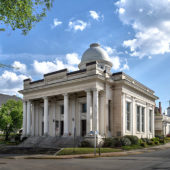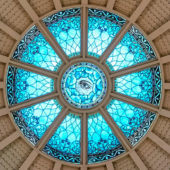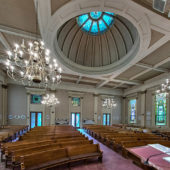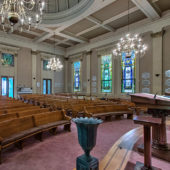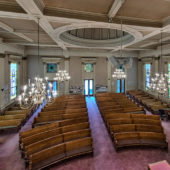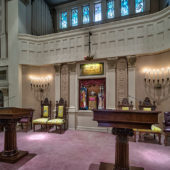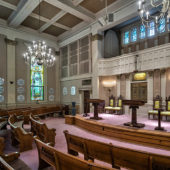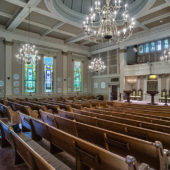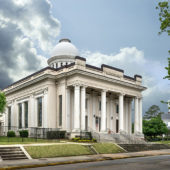A Roman-temple style structure with a stained glass Eye of G_D looking down from the domed sanctuary.
Founded in 1852, Temple Beth Israel was originally an Orthodox Congregation named Congregation Kahal Kadosh Beth Israel. It was in 1880 that Beth Israel joined the Reform Union of American Hebrew Congregations and a few years later decided that men no longer had to wear hats during services. Still, there were holdovers of the congregation’s Orthodox, German roots such as adult education classes being held in Yiddish until 1940.
The congregation’s first building was completed in 1874 at the corner of Poplar and Second Street. A serious problem with that location soon became clear. A Saturday farmer’s market became established across the street. Noisy crowds and horse-drawn wagons loaded with produce converged there on Saturdays. In that time, before air-conditioning, it was not practical to keep the synagogue closed although the noise interfered with the Sabbath services. It was decided to move, and the last services were held in that original building in June of 1901.
For a short period of time the congregation was without a permanent home until the completion of its new building in 1902. Designed by local architect Peter E. Dennis, the new synagogue is an imposing Roman-temple style building sited prominently on a hillside. The building is known for its fine stained glass windows and dome with a stained glass “Eye of G_D” looking down from the heavens into the synagogue’s sanctuary. The six windows over the choir loft, symbolic of the six days of creation, follow a design by the English artist Burne-Jones.
Macon has enjoyed a strong economy and unlike many other small southern Jewish communities its Jewish community has continued to thrive. The city’s 1937 Jewish population of 850 rose to 900 in 1980 and in recent years has plateaued at about 1000.

